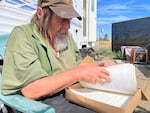Editor’s note: This is the third story in a three-part series on Oregon’s 5th Congressional District. View Part 1 here. View Part 2 here.
Election Day is Tuesday, Nov. 5. Stay informed with OPB on the presidential race, key congressional battles and other local contests and ballot measures in Oregon and Southwest Washington at opb.org/elections.

People float the Deschutes River through Bend, Ore., in the shadow of Mount Bachelor Friday, June 25, 2021.
Bradley W. Parks / OPB
Kevin Wilson is a big guy with a scruffy beard and an infectious smile. Until recently, he lived on the streets in Redmond, where he has spent much of his life. He wears a black Adidas hat with a pin depicting a popular meme. Surrounded by flames, a smiling dog holds a cup of coffee and says, “This is fine.”
“Ultimately, our goal down the road is to actually own a home,” said Wilson, 30, who lives with his wife and sister-in-law. “Taking the steps to get there — I don’t know what it’s going to take in this kind of market.”
The pin is a fitting symbol for the housing crisis in Deschutes County, a growing, scenic area with towering mountains and clear rivers perfect for recreation and tourism. Few counties in Oregon are experiencing the changes like those underway here.

Kevin Wilson, 30, holds a hat that he wears to work at BasX, an HVAC manufacturer in Redmond on August 20, 2024. Wilson is one of many people who has struggled to find an affordable place to live in Central Oregon’s housing crisis.
Bryce Dole / OPB
Related: What you need to know about voting in Oregon and Southwest Washington
As Deschutes County’s population surges, its political landscape is shifting, and its largest city is becoming increasingly liberal. At the same time, the county faces growing pains, including a shortage of affordable housing and skyrocketing costs that are pricing out many longtime residents like Wilson.
“Bend is a lot more expensive, and especially where we want to live in Bend is just not feasible right now,” said Wilson, who works at BasX, which manufactures HVAC systems in Redmond, about 15 miles north of Bend.

Kevin Wilson, left, stands with Rick Russell, right, who is a pastor at Mountain View Fellowship and the director of Redmond’s Safe Parking program. The program helps vetted participants park their vehicles at designated sites overnight and assists people like Wilson, who struggled with houselessness before recently moving into an apartment.
Bryce Dole / OPB
The county is part of Oregon’s 5th Congressional District, and the changes here could have a major impact on who wins the general election in November — a race that could determine which party controls the U.S. House of Representatives.
In the 2022 congressional election, Democratic nominee Jamie McLeod-Skinner won the county but lost overall to Lori-Chavez DeRemer, a Republican. Now the incumbent Chavez-DeRemer faces Oregon state Rep. Janelle Bynum in one of the nation’s most high-profile congressional races. A recent poll of likely district voters said the race for the swing district is a dead heat.
Related: Issues important to Oregon voters
Political change
The largest city in Central Oregon, Bend’s natural scenery has helped it change from a former timber town into a tourist destination. In just over two decades, federal records show its population has increased by nearly 50%. Deschutes County’s population grew more than any county in Oregon from 2020 to 2023, adding more than 10,200 people, according to U.S. Census data.
In the winter, skiers and snowboarders come from across the country for Mt. Bachelor’s fresh powder. In the warmer months, the area’s rugged scenery attracts rock climbers, whitewater rafters, backpackers and fly fishers. Surfers ride a man-made wave and paddle boarders lounge in the Deschutes River that curves through Bend, near a shopping area located at a former sawmill, just across the river from a large amphitheater.
“We’re not this little timber town from way back when,” said Judy Stiegler, a former Democratic state lawmaker who works as a political science instructor at the Oregon State University campus in Bend. “We’ve changed. We’ve evolved.”
Related: Listen to ‘OPB Politics Now’
About six years ago, Deschutes County had a majority of registered Republican voters, and the county had long voted reliably red, according to state data. Now there are more registered Democrats and non-affiliated voters than Republicans in the county’s part of the 5th District: 44,106 Democrats, 36,826 Republicans and 48,890 non-affiliated voters.
“Politically, the city council and the district in general has become very liberal and progressive,” said Neil Bryant, a former Republican state Senator from Bend. “And that’s not necessarily true of the county yet. It’s a little more conservative.”

The Hayden Homes Amphitheater (right) in Bend, Oregon on Aug. 21, 2023.
Joni Land / OPB
The Legislature changed the boundaries of Oregon’s 5th Congressional District in 2021, and Democrats redrew the lines to include the city of Bend. The new district map provided Democrats an opportunity to capitalize on Bend’s growth and political change in the long run. The map was approved after a walkout among Republicans who claim it was gerrymandered to make Democrats more competitive in elections. A judicial panel later dismissed the party’s legal challenge.
Bryant said this can have implications for nationally important races like Oregon’s 5th Congressional District.
“They’ve created a district that probably has a strong chance of being Democratic,” he said. “And of course the national parties know that. I bet that both Lori Chavez-DeRemer and Janelle Bynum, they’ll spend $5 million on this campaign. And it won’t be from local sources. It’ll be national because the House races and the majority there is so slim.”

Campaign images of Republican U.S. Rep. Lori Chavez-DeRemer, left, and Democrat Janelle Bynum, candidates in Oregon’s 5th Congressional District race in November 2024.
Courtesy of the campaigns / OPB
Growing pains
Over time, Bend’s growth has helped turn its downtown corridor into a vibrant space with cafes, boutiques and upscale dining. And its labor force has grown, with people moving from big cities to work in Bend, some of whom work remotely. But that growth has also placed a strain on the region’s infrastructure and has made it a harder place to afford to live, said Katy Brooks, the CEO of the Bend Chamber of Commerce.
“It’s teachers. It’s firefighters. It’s restaurant managers,” said Brooks. “It’s people who own their own business. It is an absolutely essential part of the economy. And we’ve priced them out.”
Even former mayor Craig Coyner III spent the final years of his life living on the streets of Bend. He died homeless at the age of 75.
In 2012, the median sale price for a single-family residential home in Bend was around $166,000. The estimated price now? According to two local appraisers: well over $700,000.
A report from the city’s urban renewal agency says the average annual salary needed to rent an apartment in Bend is $72,000, OPB reported. The city’s annual median income is $104,700, but half of the jobs in the Bend-Redmond area pay $43,000 or less.
“It can be especially difficult for teachers who are just beginning their career to find a place to live in Central Oregon,” said Jonathan Kelly, 32, an eighth-grade math teacher who coaches high school track and middle school cross country in Sisters. To afford a place to live, he said, “I know financially if I did not coach I would need to more or less work in the summer as well.”
A drive across Redmond
Meanwhile, the number of people experiencing homelessness across Central Oregon has increased in recent years, and county leaders have clashed again and again over how to manage large homeless encampments near Bend and Redmond.
“Housing costs are outrageous,” said Rick Russell, a pastor at Mountain View Fellowship and the director of Redmond’s Safe Parking program.
The program regularly helps about 50 vetted participants park their vehicles at designated sites overnight. County leaders credited the program with helping lead to a decrease in homelessness in Redmond last year.
Russell says the people in the program are of all ages, but many are elderly people who are physically unable to go back to work and are living on social security or disability — about $800 to $1200 a month. He said many lost their homes after being longtime Central Oregon residents. And with a shortage of supply, some might wait for years on affordable housing waitlists.
“Some of them will die before their number ever comes up,” said Russell.

Jon Stoneman, 68, stands near a construction site outside of Redmond on August 20. A former house painter, Stoneman has lived in Central Oregon for much of his life and now lives in a trailer.
bryce dole / OPB
On an August afternoon, Russell and program staff hopped in their car and drove across Redmond to visit one of them: Jon Stoneman, a 68-year-old former house painter who moved into a trailer after his job as a caregiver concluded and he broke his back.
He was one of five people in their 60s living in vehicles on a site beside a construction area in Redmond. There’s no power or water, but it’s a place where Russell and his staff can help people take steps toward housing.
Stoneman has a white beard, and wears a green shirt and vest with glasses atop his hat. Over his lifetime, Stoneman has watched Deschutes County grow and home prices become untenable.
“It wasn’t thriving the way it is now. What they call housing for lower income, it’s beyond the capability of most poor people I come into contact with,” he said, adding: “I understand, ‘Not in my backyard,’ but I don’t know what to tell ‘em.”

Jon Stoneman, 68, flips through some of his writing at his trailer in Redmond on Aug. 20, 2024. Stoneman is among many people who experience houselessness as housing prices surge across Central Oregon.
Bryce Dole / OPB
Then Russell and program staff drove to BasX, located along the bustling U.S. 97 that splits Central Oregon, to see Wilson during his lunch break.
Wilson grew up in California. His dad had a government job and would buy him anything he’d ask for. But cascading challenges — his parents’ divorce and his father’s death among them — ultimately ended with him couch surfing, living in an RV and out on the streets. The Safe Parking program helped him move from his RV into an apartment in Redmond.
“For the first time in my life, I just stared out the windows and was like, I finally made it,” said Wilson.
In recent years, Wilson has noticed a growing number of people moving from California to Central Oregon. Now, at work at BasX — which employs more than 500 people — there are people from all over the world: Thailand, China, Africa. Some people say out of towners are driving up prices and damaging Central Oregon’s small-town culture. Wilson sees it differently.
“Not only do we need to grow as an economy, but we need to grow as people,” he said. “And being accepting of others is ultimately the end goal for everybody. Because if we can’t live together, what good is growing together?”



